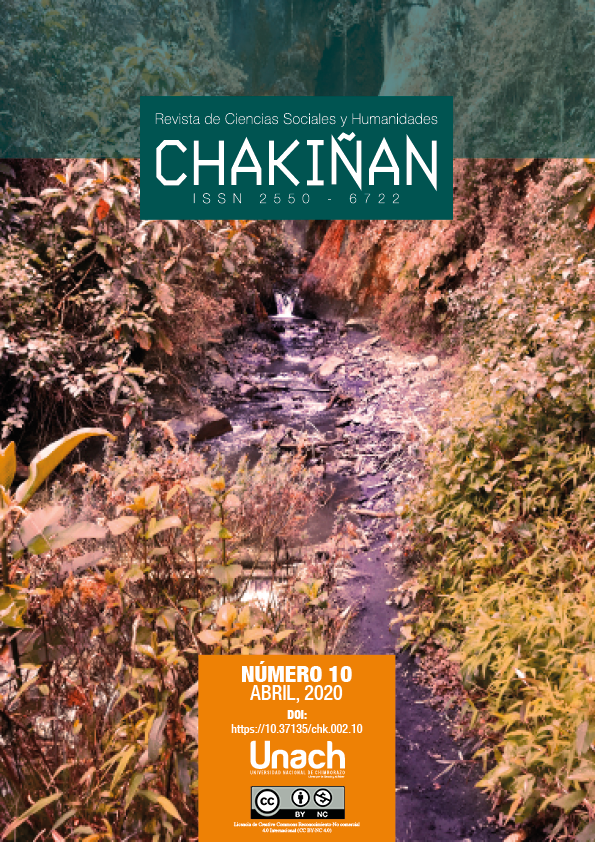IDENTITY, PERSON AND PERSONHOOD AMONG PREHISPANIC MAYAS
Main Article Content
Abstract
The present study has as a general objective to explore the Mayan identities during pre-Hispanic times from a current perspective. From this general objective, two particular objectives give rise to this research: 1) Study it differently compared to traditional anthropology, the issue of identity and the person in archeology. 2) Understand how the Mayan ruling elite built their identities and personalities. The methodological process that was followed for the preparation of the present study was the following: theoretical contrast of the personhood concept, compared to other categories such as individual identity and person, search for indicators from different disciplinary resources, cross-disciplinary interdisciplinary information. The empirical information used comes from mortuary contexts, spaces and tombstones, all of them studied from archeology; fundamental part were the epithets studied from epigraphy, as well as symbols and representations comprised from iconography. This whole process resulted in understanding how the Mayan rulers of the Classic period (300-900 AD) built their identities and personalities, specifically in cities such as Calakmul, Ekbalam, Yaxchilan, Copan and Oxtancah.
Downloads
Article Details
Conference Proceedings Volume
Section
Responsibility of the authors:
The authors are responsible for the ideas and data collected in the manuscripts. They are additionally accountable for the fidelity of the information, the correction of the citations, the right to publish any material included in the text, and the presentation of the manuscript in the format required by the Journal (WORD template). A manuscript forwarded to CHAKIÑAN must not have been published before, nor must it have been submitted to another means of publication.
Copyright:
Published articles do not necessarily compromise the viewpoint of the CHAKIÑAN JOURNAL. The Journal is aligned to the policy of the licence de Creative Commons Reconocimiento-No comercial 4.0 Internacional (CC BY-NC 4.0). Each author retains the right to the paper published in the Chakiñan journal.
Privacy statement
The personal data and email addresses entered in this magazine will be used exclusively for the purposes stated by the publication and will not be available for any other purpose or person.
How to Cite
Share
References
Colas, P. (2003). K’inich and King. Naming self and person among Classic Maya rulers. Ancient Mesoamerica, 14, 269-283.
Concepción, W. (2015). Identidad personal de dos gobernantes mayas de Yaxchilan: Itzamnaaj B’ahlam y Yaxuun B’ahlam (tesis de grado). Universidad Autónoma de Yucatán, México.
Hernández, H. & Pool, M. (2010). Identidades y cultura material en la región maya. Mérida: Universidad Autónoma de Yucatán.
Fash, W. (1991). Lineage Patrons and Ancestor Worship among the Classic Maya Nobility: The Case of Copán Structure 9N-82. En Merle Green Robertson and Virginia Miller Fields (eds). Sixth Palenque Round Table, 1986, (pp. 68-80). Norman: University of Oklahoma Press.
Fitzsimmons, J. (1998). Classic Maya Mortuary Anniversaries at Piedras Negras, Guatemala. Ancient Mesoamerica, 9, 271-278.
Fitzsimmons, J. (2003). Reyes difuntos y costumbres funerarias: Epigrafía y arqueología de la muerte en la sociedad Maya Clásica. En J. Laporte, B. Arroyo, H. Escobedo y H. Mejía (eds.). XVI Simposio de Investigaciones Arqueológicas en Guatemala, (pp. 672-678). Guatemala: Museo Nacional de Arqueología y Etnología.
Fowler, Ch. (2004). The Archaeology of Personhood. An anthropological approach. London: Routldge.
García, H. (2019). La montaña sagrada. Aspectos sobre la legitimación del poder en el Clásico maya. Estudios de cultura maya, LIII, 139-172.
Graniel, M. (2012). Estudios del personhood en las tierras bajas centrales mayas durante el Clásico (tesis de grado). Universidad Autónoma de Yucatán, México.
Hocart, A. (1970). Kings and Councilliors: An Essay in the Comparative Anatomy of Human Society. Chicago: University of Chicago Press.
Houtson, S. & Stuart, D. (1996). Of Gods, Glyphs and Kings: Divinity and Rulership among the Classic Maya. Antiquity, 70, 289-312.
Kantorowicz, E. (1957). The Kings Two Bodies: A Study in Mediaeval Political Theology. Princeton: Princeton University Press.
Lacadena, A. (2003). El Corpus Glífico de Ek’ Balam, Yucatán, México. México: FAMSI. Recuperado de http://www.famsi.org/reports/01057es/
Martin, S. & Grube, N. (2000). Chronicle of the Maya kings and queens. London: K R, Londres, Thames and Hudson.
Martín, G. (2013). Análisis de la identidad individual de los gobernantes mayas del Clásico. Los casos de Ukit Kan Lek Tok’, K’inich Janaab Pakal y K’inich Yax K’uk Mo (tesis de grado). Universidad Autónoma de Yucatán, México.
Méndez, L. (1992). I Seminario Sobre Identidad. México: Instituto de Investigaciones Antropológicas, UNAM.
Pool, M. (2003). Sistemas de descendencia y parentesco entre los mayas prehispánicos. Crítica al modelo de linaje (tesis de maestría). Universidad Autónoma de Yucatán, México.
Ricoeur, P. (2003). Sí mismo como otro. Madrid: Siglo XXI.






